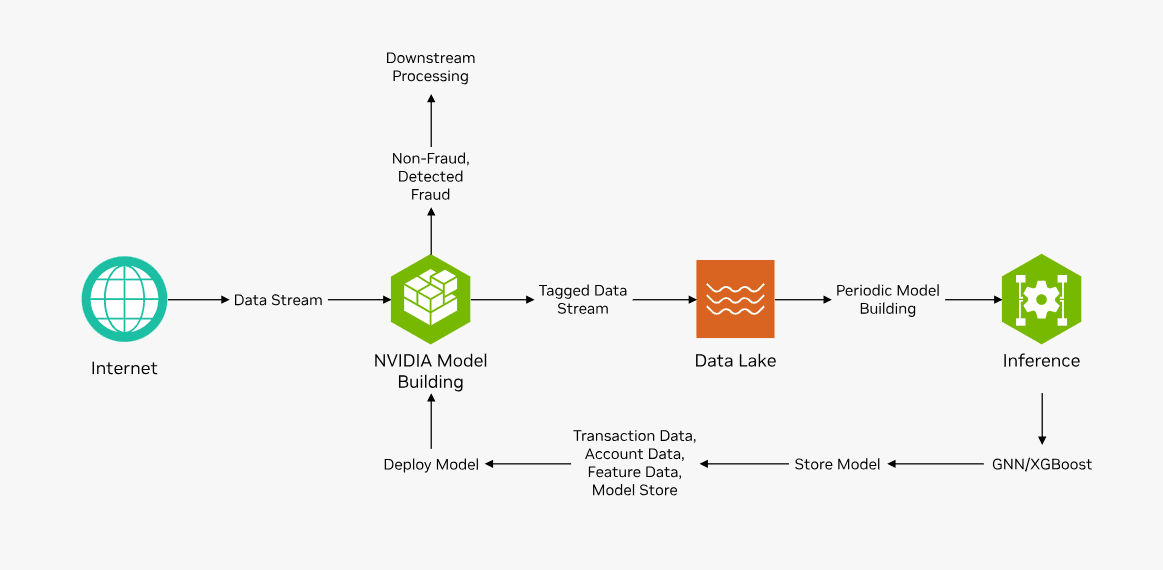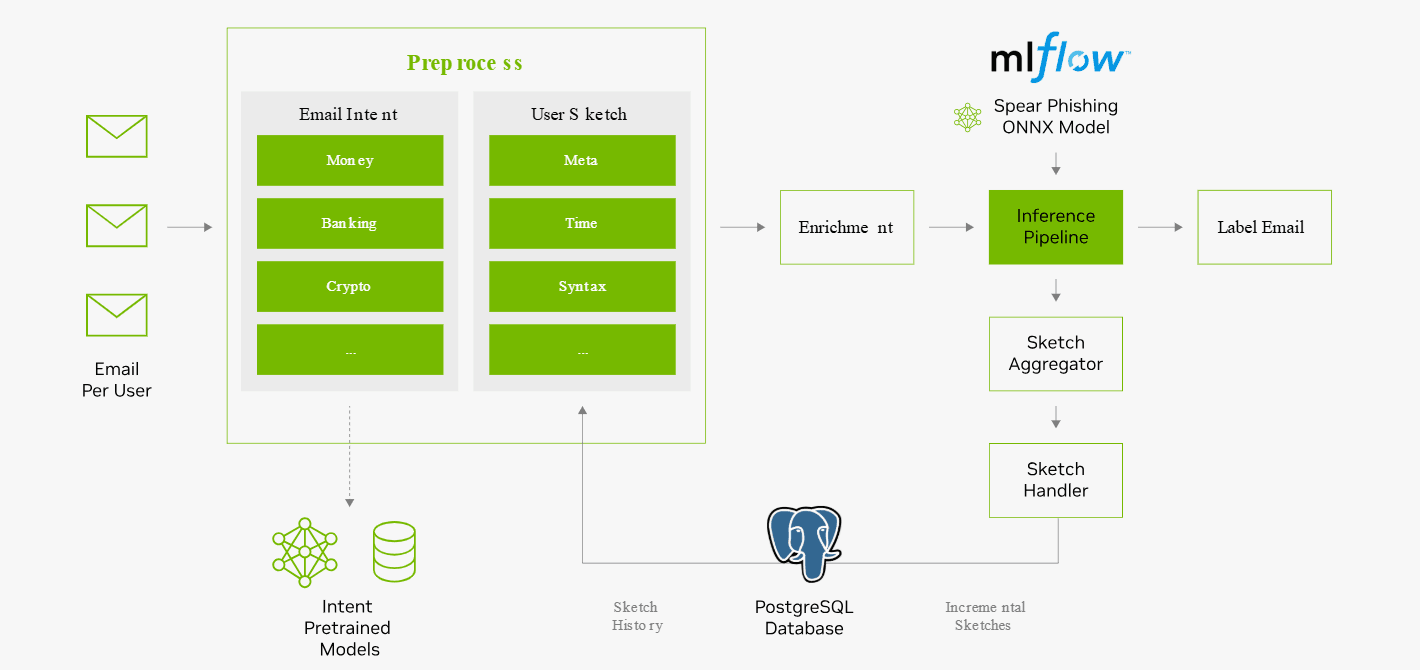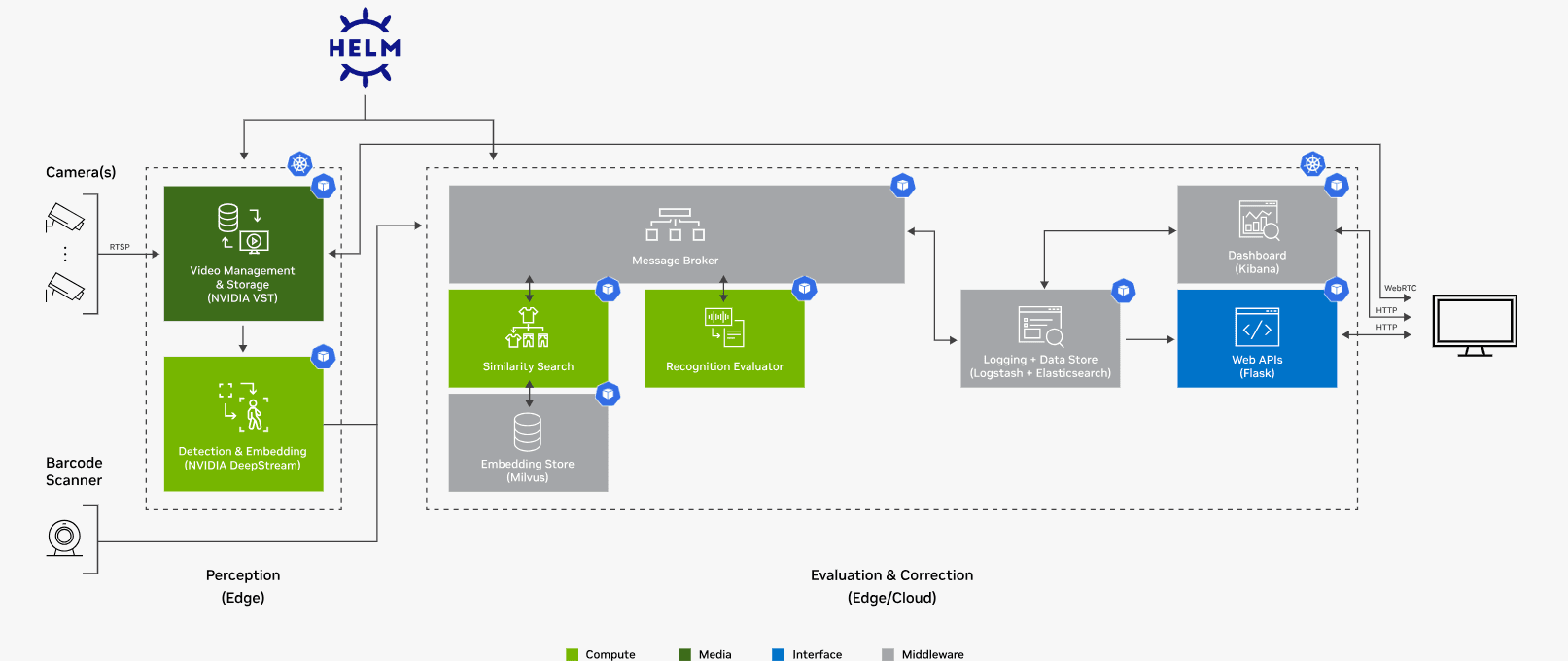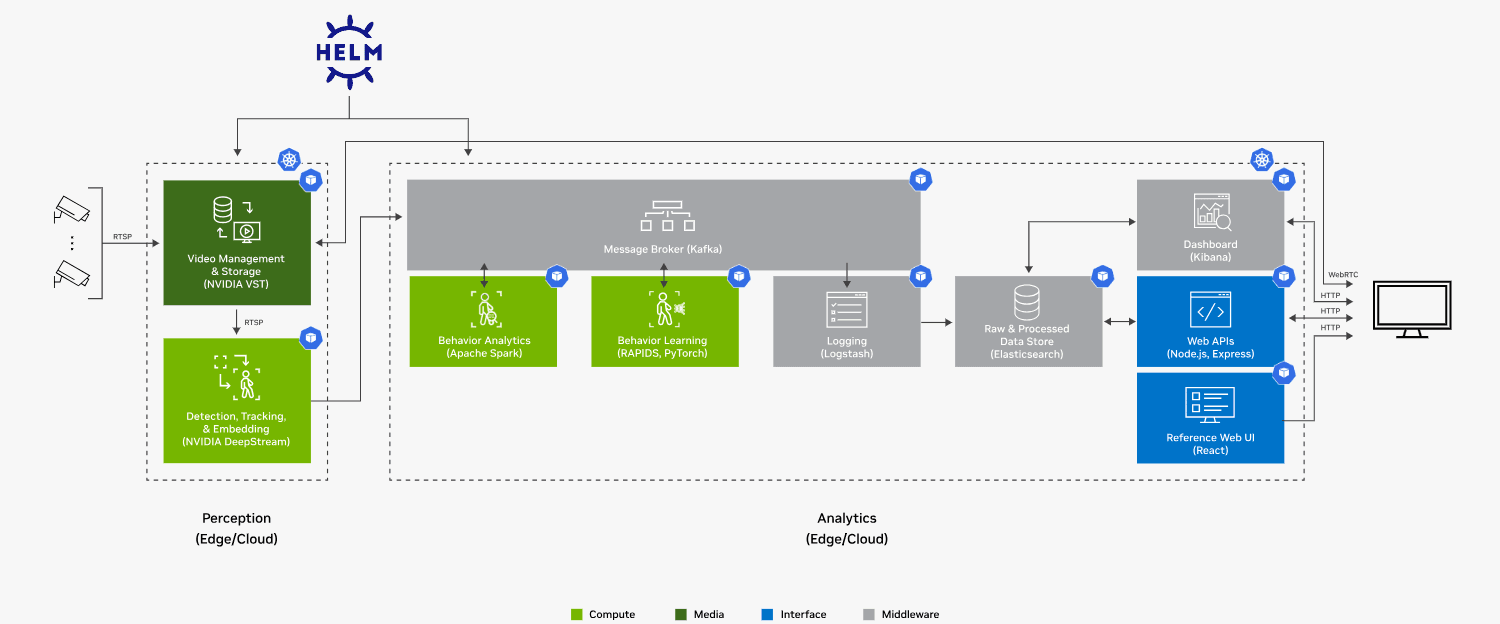business resources
NVIDIA AI Blueprints: Accelerating Generative AI Solutions Across Industries
28 Nov 2024, 1:50 pm GMT
NVIDIA AI Blueprint is a tool aimed at improving video search and summarisation in various industries. Companies like Accenture, Dell, and Lenovo are using this blueprint to create visual AI agents that boost productivity and safety. NVIDIA is also integrating AI features with applications like Obsidian to simplify content creation and data management.
NVIDIA AI Blueprints are comprehensive, cloud-native frameworks offering pre-trained, customisable AI workflows. They cater to a range of generative AI use cases, enabling enterprises to operationalise sophisticated AI applications and create data-driven AI ecosystems.
Blueprints provide a robust combination of NVIDIA's proprietary tools, such as the NeMo framework, NIM microservices, and Omniverse libraries, as well as partner microservices and Helm charts for deployment. These workflows are adaptable, allowing developers to incorporate their own business data and customise AI applications tailored to their unique requirements.
Enterprises leveraging NVIDIA AI Blueprints can build applications that operate seamlessly across accelerated data centres, edge computing environments, and cloud platforms. Key elements of NVIDIA Blueprints include:
- Reference code for developers to build custom applications.
- Partner microservices to expand functionality.
- Helm charts for deployment in cloud-native environments.
- Customisation documentation to adapt workflows to specific business needs.
The core of NVIDIA AI Blueprints lies in their integration with advanced technologies, including:
- Vision Language Models (VLMs): These models, such as NVIDIA VILA, combine computer vision and natural language processing to understand and interpret video data.
- Large Language Models (LLMs): Models like Meta’s Llama 3.1 405B power the natural language capabilities, allowing users to easily query video content.
- NVIDIA NIM Microservices: A powerful set of microservices that includes industry-standard APIs, optimised inference engines, and domain-specific code, enabling smooth deployment across various platforms.
By utilising NVIDIA AI Blueprints, enterprises can create data-driven AI flywheels, which enable continuous learning and improvement in AI systems through interaction and real-time data processing. These tools offer immense flexibility, allowing developers to customise solutions to meet specific business requirements without the need to build applications from scratch.
The workflow of NVIDIA AI Blueprints follows several key steps:
- Ingestion: AI agents collect video data from live streams or archived content.
- Analysis: The system processes visual and contextual data using Vision Language Models (VLMs) and Large Language Models (LLMs), identifying objects and events.
- Summarisation: Retrieval-augmented generation (RAG) techniques are used to create detailed summaries, focusing on important moments or insights.
- Interactive querying: Users can ask questions in natural language, and the AI provides relevant responses.
- Alert generation: The system sends alerts for specific situations, such as safety breaches or equipment malfunctions.
Applications of NVIDIA AI Blueprints
NVIDIA AI Blueprints offer transformative capabilities across industries, enabling enterprises to harness the power of generative AI for real-world applications. Here are some of the key workflows and their use cases:
1. Video search and summarisation
- With visual language models (VLMs) and large language models (LLMs), Blueprints allow businesses to process large volumes of live or archived video content.
- AI agents can extract actionable insights, perform summarisation, and provide interactive Q&A capabilities, aiding industries like media, surveillance, and education.
2. Digital human for customer service
- Powered by NVIDIA Tokkio technologies, this Blueprint enables the creation of AI-driven 3D avatars for personalised customer interactions.
- Enterprises can deliver engaging user experiences that surpass traditional customer service methods.
3. Multimodal PDF data extraction
- This Blueprint focuses on retrieval-augmented generation (RAG) workflows. It uses NVIDIA NeMo Retriever NIM microservices to extract and process vast amounts of data from enterprise PDFs.
- Applications include creating chatbots or AI agents capable of answering complex queries based on company data.
4. Generative virtual screening for drug discovery
- Designed for pharmaceutical research, this workflow uses generative AI models to identify promising drug candidates.
- Tools like AlphaFold2 and DiffDock accelerate molecular docking, reducing drug discovery timelines and costs.
5. Cybersecurity enhancements
- Blueprints enable the detection of cybersecurity threats, such as spear phishing and insider risks, through generative AI-driven workflows.
- The digital fingerprinting workflow identifies anomalies at scale, improving security without increasing false positives.
6. Retail and logistics
- Applications like multi-camera tracking and retail loss prevention help retailers optimise operations and reduce theft.
- In logistics, route optimisation workflows tackle complex vehicle-routing problems, balancing cost and time constraints.
7. Real-time computer-aided engineering
- Blueprints support the development of digital twins for manufacturing design and simulation, combining physics-ML, accelerated solvers, and real-time rendering.
What are NVIDIA NIM and NeMo?
NVIDIA NIM Microservices
NVIDIA Intelligent Microservices (NIM) is a core component of NVIDIA's AI ecosystem, designed to support the development and deployment of scalable and industry-specific AI applications. It serves as a versatile framework that provides the tools and infrastructure necessary for building robust AI solutions. NIM includes:
- Domain-specific APIs: Customised for different industries and specific use cases.
- Optimised inference engines: Designed to provide high performance across various deployments.
- Enterprise runtime: Supports large-scale AI applications with strong infrastructure.
Applications of NIM
- AI Blueprints: NIM forms the foundation of NVIDIA AI Blueprints, which are ready-to-use templates for deploying AI in specific domains.
- Industry solutions: NIM enables enterprises to implement tailored AI solutions, leveraging pre-built microservices that align with their operational needs.
- Scalability and flexibility: Its microservices architecture ensures that applications can scale seamlessly as demand grows.
NeMo Platform
The NeMo platform focuses on enabling developers to customise and fine-tune AI models for specialised environments. It simplifies the AI model development process by providing tools for data enhancement and model customisation. Key features of NeMo
- Model fine-tuning: Allows developers to fine-tune pre-trained models to meet specific operational requirements. Supports popular frameworks and architectures for tasks like speech recognition, natural language processing (NLP), and text-to-speech (TTS).
- Synthetic Data Generation (SDG): Enhances datasets by generating high-quality synthetic data. Facilitates better training of AI models, especially when real-world data is scarce or imbalanced.
- Support for Large Language Models (LLMs): Integrates with NVIDIA's Megatron framework to enable efficient training of large-scale language models. Facilitates advanced applications such as conversational AI, summarization, and question-answering systems.
Applications of NeMo
- Speech and Language AI: Used to develop state-of-the-art models for speech recognition, language translation, and more.
- Custom AI Solutions: Helps industries create AI systems tailored to their unique datasets and operational needs.
- Dataset Augmentation: Enhances model accuracy and robustness by using synthetic data to fill gaps in real-world datasets.
How NIM and NeMo complement each other
- End-to-end development: NIM provides the microservices and runtime environment for scalable AI applications, while NeMo offers the tools for model customisation and dataset enhancement.
- Industry-specific AI: Together, these platforms allow developers to create AI solutions tailored to the specific requirements of different industries, combining robust infrastructure with precise model tuning.
- Efficiency and accuracy: While NIM ensures scalability and performance, NeMo boosts model accuracy by leveraging advanced data generation and fine-tuning capabilities.
NVIDIA AI Blueprints: Collaborations and industry adoption
NVIDIA has partnered with global technology providers, including Accenture, Dell Technologies, Lenovo, and Cisco, to enhance the accessibility and deployment of AI Blueprints. These partnerships ensure that businesses across sectors can seamlessly integrate AI solutions into their operations.
- Accenture: By integrating NVIDIA’s workflows into its AI Refinery, Accenture helps clients quickly build customised AI systems, improving customer service and operational efficiency.
- Manufacturing: AI agents are being used to monitor production lines for safety compliance, helping to reduce workplace hazards and increase efficiency.
Advancing Generative AI with vision language models
NVIDIA AI Blueprints use Vision Language Models (VLMs) such as NVIDIA VILA and Large Language Models (LLMs) like Meta’s Llama 3.1 405B. These technologies allow AI agents to:
- Understand and process both visual and textual information.
- Extract useful insights from video and image feeds.
- Enable natural language interactions, making it easier for users to engage.
Additionally, the use of retrieval-augmented generation (RAG) helps agents gather insights from the data, create detailed summaries, and build knowledge graphs. This enhances understanding of the relationships between events, objects, and situations.
Exploring NVIDIA AI Blueprint: AI workflows and use cases
NVIDIA AI Blueprint offers a comprehensive set of AI workflows tailored to various industries, enabling businesses to accelerate their development and achieve AI-driven outcomes. Below are the detailed use cases and workflows supported by NVIDIA, written in British English.
Financial Services
Fraud Detection: Fraudulent activities in financial transactions pose a $43 billion annual challenge to financial institutions globally. NVIDIA’s fraud detection AI workflow enables organisations to detect and prevent sophisticated fraud while reducing false positives, enhancing the accuracy of transaction monitoring.

Key Features:
- Reference Solution: Designed for large-scale credit card fraud detection, it leverages the NVIDIA Triton™ Inference Server to deliver high-speed and scalable model inference.
- Advanced Model Training: Integrates Graph Neural Networks (GNNs) for advanced feature extraction, feeding into an XGBoost model to enhance prediction accuracy.
- Data Processing at Scale: Utilises the NVIDIA Morpheus SDK for massive data processing, ensuring real-time analytics.
- Customisation and Deployment: Includes Jupyter Notebooks to help organisations adapt the workflow to their specific data and operational needs.
Cybersecurity
Insider Threat Detection: NVIDIA’s digital fingerprinting AI workflow tackles the growing challenge of securing vast enterprise networks by uniquely identifying users, services, and machines through unsupervised learning. It enables real-time anomaly detection and actionable intelligence, safeguarding enterprises from insider threats.

Key Features:
- Unique User Profiling: Digital fingerprinting creates distinct profiles for every user and system across a network, enabling anomaly detection at scale.
- Cloud-Native Deployment: Provides Helm charts for seamless deployment across cloud environments.
- Customisable Pipelines: Offers training and inference pipelines for tailoring to specific organisational needs.
Spear Phishing Detection: Spear phishing is among the most costly cybersecurity threats, often bypassing traditional defences due to its targeted and convincing nature. NVIDIA’s AI workflow leverages generative AI and natural language processing (NLP) to enhance phishing detection accuracy.

Key Features:
- Pretrained NLP Models: Analyses and classifies email content to detect spear phishing attempts with up to 21% greater accuracy than existing methods.
- Generative AI Training: Utilises NVIDIA NeMo™ to generate synthetic phishing emails for scalable model training in under 24 hours.
- Real-Time Protection: Adds an additional layer of defence by profiling email interactions and integrating with other Morpheus AI workflows.
Customer Service
Enterprise Retrieval-Augmented Generation (RAG): The RAG workflow empowers enterprises to build advanced AI chatbots capable of providing accurate and conversational responses to enterprise-specific queries by connecting large language models (LLMs) to proprietary data.
- Key Features:
- Integrated Pipeline: Combines NVIDIA NeMo™ Retriever, NIM™ microservices, LangChain, and LlamaIndex for robust retrieval and response generation.
- Customisation and Scalability: Offers APIs compatible with OpenAI for seamless integration and deployment on GPU-optimised platforms.
- Quick Deployment: Simplifies workflow orchestration with Docker Compose and delivers optimised LLM inference performance.
Retail
Multi-Camera Tracking: Retailers are transforming customer experience and security by tracking customer journeys and object movements across multiple cameras using NVIDIA’s Multi-Target, Multi-Camera (MTMC) workflow.

Key Features:
- Object Detection and Tracking: Uses NVIDIA DeepStream SDK and pretrained models to detect and associate objects across different camera views.
- Privacy-Focused Technology: Tracks objects based on visual embeddings rather than personal biometric data.
- Cloud-Native Architecture: Deployable at scale using Kubernetes and managed through Helm.
Retail Loss Prevention: Retail product shrinkage, driven primarily by theft, results in annual losses of over $100 billion. NVIDIA’s loss prevention workflow enables retailers to deploy AI-powered solutions to prevent product theft.

Key Features:
- Pretrained Models: Recognises frequently stolen items, such as alcohol and high-value goods, and adapts to new products through few-shot learning techniques.
- Active Learning: Employs NVIDIA Omniverse™ for synthetic data generation to expand and fine-tune product recognition capabilities.
- Comprehensive Deployment: Offers cloud-native microservices for barcode and cross-camera product identification.
Retail Shopping Advisor
NVIDIA’s generative AI-powered shopping advisor delivers interactive and personalised shopping experiences by integrating retrieval-augmented generation (RAG) technology.
Key Features:
- End-to-End RAG Pipeline: Leverages NVIDIA NeMo™ Retriever and NIM™ microservices to connect LLMs with retail catalogues for accurate query responses.
- Customisation: Provides tools for adapting the solution to specific data and business needs.
- Deployment Options: Supports on-premises and cloud-based deployment for scalability.
Retail Store Analytics: Using NVIDIA’s vision AI technology, retailers can gain actionable insights through advanced analytics, such as queue monitoring, heat mapping, and customer trajectory tracking.

Key Features:
- Pretrained AI Models: Enable real-time behaviour analytics for occupancy, dwell time, and proximity analysis.
- Customisable Dashboards: Facilitate visualisation of insights for optimising store layouts, staffing, and merchandising.
Accelerated Optimisation
Route Optimisation: NVIDIA’s route optimisation workflow addresses complex vehicle-routing problems, enabling organisations to optimise delivery routes, minimise costs, and adapt to dynamic constraints in real-time.

Key Features:
- Advanced Solver Pipeline: Utilises NVIDIA cuOpt™ to find optimal routes for large fleets.
- Cloud-Native Deployment: Includes Helm charts, Jupyter Notebooks, and sample Python code for rapid integration.
NVIDIA AI workflows showcase the latest in technology, offering tailored solutions for specific industries that shorten development times, improve operational accuracy, and support scalability. With ready-made, adaptable, and cloud-based applications, organisations can confidently speed up their AI adoption and transition smoothly from pilot projects to large-scale production. These workflows enable businesses to innovate, adapt, and thrive in a data-focused world.
Share this
Pallavi Singal
Editor
Pallavi Singal is the Vice President of Content at ztudium, where she leads innovative content strategies and oversees the development of high-impact editorial initiatives. With a strong background in digital media and a passion for storytelling, Pallavi plays a pivotal role in scaling the content operations for ztudium's platforms, including Businessabc, Citiesabc, and IntelligentHQ, Wisdomia.ai, MStores, and many others. Her expertise spans content creation, SEO, and digital marketing, driving engagement and growth across multiple channels. Pallavi's work is characterised by a keen insight into emerging trends in business, technologies like AI, blockchain, metaverse and others, and society, making her a trusted voice in the industry.
previous
Improve Cash Flow With a Proactive Debt Collection Strategy
next
Creative OOH Advertising Ideas to Capture the Attention of Your Target Market